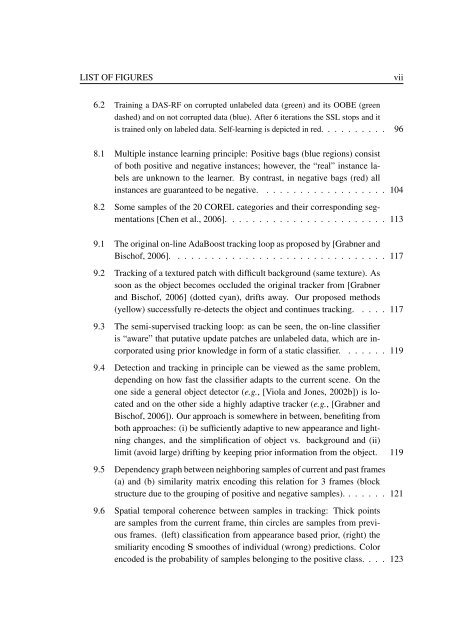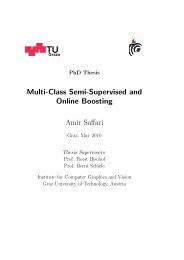PhD Thesis Semi-Supervised Ensemble Methods for Computer Vision
PhD Thesis Semi-Supervised Ensemble Methods for Computer Vision
PhD Thesis Semi-Supervised Ensemble Methods for Computer Vision
Create successful ePaper yourself
Turn your PDF publications into a flip-book with our unique Google optimized e-Paper software.
LIST OF FIGURES<br />
vii<br />
6.2 Training a DAS-RF on corrupted unlabeled data (green) and its OOBE (green<br />
dashed) and on not corrupted data (blue). After 6 iterations the SSL stops and it<br />
is trained only on labeled data. Self-learning is depicted in red. . . . . . . . . . 96<br />
8.1 Multiple instance learning principle: Positive bags (blue regions) consist<br />
of both positive and negative instances; however, the “real” instance labels<br />
are unknown to the learner. By contrast, in negative bags (red) all<br />
instances are guaranteed to be negative. . . . . . . . . . . . . . . . . . . 104<br />
8.2 Some samples of the 20 COREL categories and their corresponding segmentations<br />
[Chen et al., 2006]. . . . . . . . . . . . . . . . . . . . . . . . 113<br />
9.1 The original on-line AdaBoost tracking loop as proposed by [Grabner and<br />
Bischof, 2006]. . . . . . . . . . . . . . . . . . . . . . . . . . . . . . . . 117<br />
9.2 Tracking of a textured patch with difficult background (same texture). As<br />
soon as the object becomes occluded the original tracker from [Grabner<br />
and Bischof, 2006] (dotted cyan), drifts away. Our proposed methods<br />
(yellow) successfully re-detects the object and continues tracking. . . . . 117<br />
9.3 The semi-supervised tracking loop: as can be seen, the on-line classifier<br />
is “aware” that putative update patches are unlabeled data, which are incorporated<br />
using prior knowledge in <strong>for</strong>m of a static classifier. . . . . . . 119<br />
9.4 Detection and tracking in principle can be viewed as the same problem,<br />
depending on how fast the classifier adapts to the current scene. On the<br />
one side a general object detector (e.g., [Viola and Jones, 2002b]) is located<br />
and on the other side a highly adaptive tracker (e.g., [Grabner and<br />
Bischof, 2006]). Our approach is somewhere in between, benefiting from<br />
both approaches: (i) be sufficiently adaptive to new appearance and lightning<br />
changes, and the simplification of object vs. background and (ii)<br />
limit (avoid large) drifting by keeping prior in<strong>for</strong>mation from the object. 119<br />
9.5 Dependency graph between neighboring samples of current and past frames<br />
(a) and (b) similarity matrix encoding this relation <strong>for</strong> 3 frames (block<br />
structure due to the grouping of positive and negative samples). . . . . . . 121<br />
9.6 Spatial temporal coherence between samples in tracking: Thick points<br />
are samples from the current frame, thin circles are samples from previous<br />
frames. (left) classification from appearance based prior, (right) the<br />
smiliarity encoding S smoothes of individual (wrong) predictions. Color<br />
encoded is the probability of samples belonging to the positive class. . . . 123



